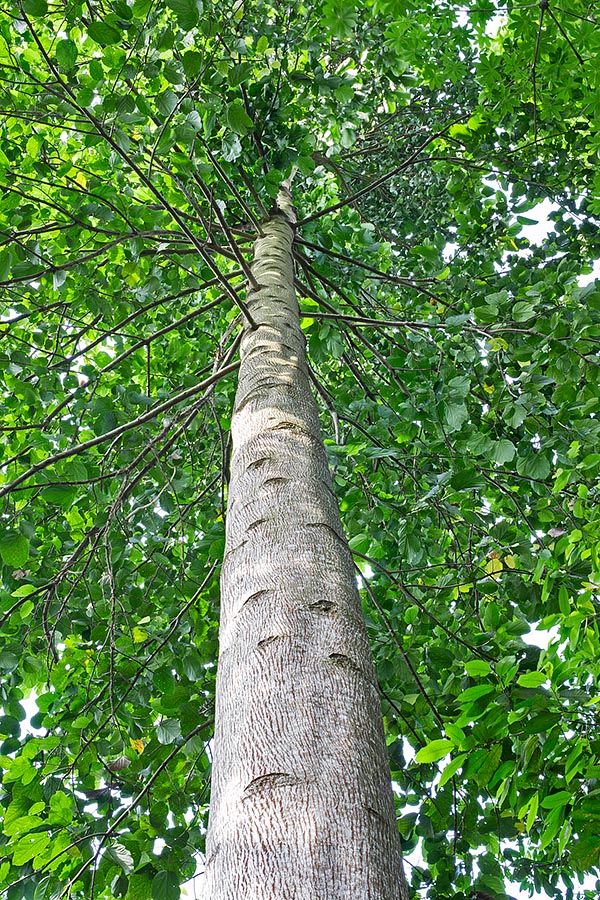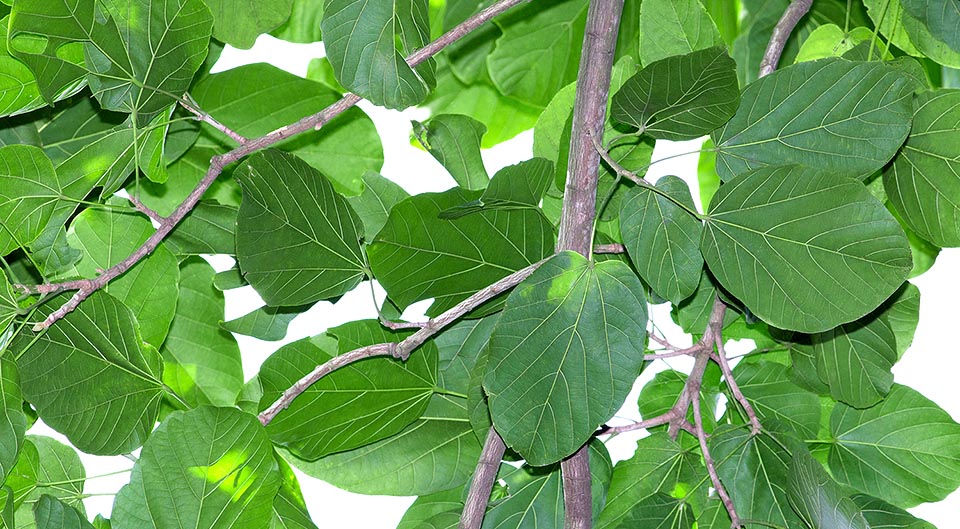Family : Malvaceae

Text © Pietro Puccio

English translation by Mario Beltramini

In the open forests of South-East Asia, the Pterygota alata can be 35 m tall with 1 m trunk © G. Mazza
The name of the genus comes from the combination of the Greek substantives “πτερύγιον” (pterygion) = wing and “οὖς, ὠτός” (ous, otόs) = ear; the specific name from the Latin adjective, “alatus, a, um” = winged, both with reference to the winged seeds.
Common names: Buddha’s coconut tree, tropical chestnut (English); Buddha narikella, tula (Bengali); haron, letkok, sin-kadet, taung-letkok (burmese); chi ping po (Chinese); pahari (Hindi); po dêng (Lao); kolugida, daddele (Kannada); anathondi, kavalam, kudatthanni, poola (Malayalam); kangsar (Malay); anathondi, kodaittondi (Tamil); huaka, mabin, tongching (Thai); bandha narikella (Urdu); cước mộc, chọc mọc, sảng cánh, trôm nước (Vietnamese).
The Pterygota alata (Roxb.) R.Br. (1844) is an evergreen or semi-deciduous tree very ramified, up to 30-35 m tall, with erect trunk, cylindrical, of up to more than 1 m of diameter, with greyish bark, provided at the base of tabular roots (flattened roots similar to buttresses).
The leaves, on a 3-12 cm long petiole, are simple, alternate, grouped at the apex of the branches, ovate-cordate with obtuse or acute apex and entire or slightly wavy margin, 10-30 cm long and 8-18 cm broad, glabrous, rather coriaceous, of intense green colour.
The inflorescences are axillar panicles, on the one year old branches without leaves, bearing unisexual flowers, for partial abortion of the organs of the other sex, simultaneously present on the same in florescence. The flowers, devoid of petals, have campanulate calyx, 1,5-2 cm long, divided up to almost the base in 5 linear-lanceolate segments with retroflexed apex, about 0,4 cm broad, fleshy, covered by a tomentum of rusty colour externally, streaked with red and yellow internally, with an odour judged by some as unpleasant. Male flowers with anthers grouped at the apex of the androgynophore, about 0,5 cm long, female flowers with extremely short androgynophore, globose superior ovary with staminodes at the base, pubescent, 5 free carpels and short, curved, styles with bilobate stigma. The fruits are follicles, on a long stem, globose, slightly compressed laterally, woody and covered by brown tomentum, 10-12 cm long and of about 9 cm of diameter, containing numerous flat seeds provided of a long and wide wing, 5-8 cm long overall, of brown colour.
It propagates by seed, that has a germinability lasting some months, in draining sandy loam maintained humid at the temperature of 24-26 °C, with germination times of 1-3 months. Tree of undoubtful ornamental characteristics due to the luxuriant foliage and the showy fruits almost as big as a coconut (Cocos nucifera L., hence one of its most diffused common names) utilizable as shade tree in parks and gardens and as road tree in the tropical, subtropical and marginally temperate warm climate regions, where temperatures just under the 0 °C are short-lasting exceptions.

Leaves rich of antioxidants. The fruits seem coconuts and the seeds, consumed roasted by the locals, are dispersed by the wind and are part of the monkeys diet © G. Mazza
It requires full sun and adapts to various types of soil, provided draining. The seeds are consumed roasted by some local populations and it seems that they hold narcotic properties, they also are part of the diet of various species of monkeys; the oil gotten from the seeds is utilized for lighting and could be advantageously used as biofuel. The wood, of whitish colour, light and short lasting, is utilized for furniture, boxes, sticks, toys, handicrafts and in the fabrication of the plywood. The dried follicles are variously utilized for decorative purposes and from the bark are obtained robust fibres for cordages.
Laboratory studies have evidenced in the extracts of the leaves the presence of compounds with high antioxidant activity liable to further investigations.
Synonyms: Sterculia alata Roxb. (1820); Pterygota roxburghii Schott & Endl. (1832); Clompanus alata (Roxb.) Kuntze (1891).
→ To appreciate the biodiversity within the MALVACEAE family please click here.
